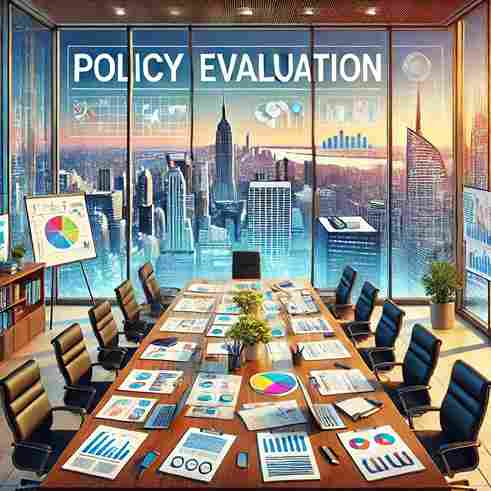Policy Evaluation: Examining the Types and Schools of Thought in Public Policy Analysis
Policy Evaluation Policy evaluation, or policy assessment, is an essential component of the public policymaking process. It involves analyzing and reviewing the outcomes and impacts of policies, programs, and governmental strategies, providing valuable insights for policymakers and decision-makers to refine, revise, or implement policies effectively. Policy evaluation serves as an analytical tool in policymaking, particularly in modern and complex societies, by think thanks … is of particular importance, as it can enhance the effectiveness and efficiency of policies and ultimately improve Governance can help improve governance effectiveness. This note explores the concept of policy evaluation, different types and approaches to policy assessment, and its impact on policymaking in a structured manner.
Definition of Policy Evaluation
Policy evaluation is a systematic process of collecting and analyzing information about a public policy to determine its effectiveness, efficiency, and impact on social, economic, and environmental conditions. The primary goal of policy evaluation is to inform decision-makers about the outcomes of previous decisions and assist them in making more informed choices for future processes (Patton, 2008). This process can be conducted directly or indirectly through quantitative and qualitative indicators.
Policy Evaluation not only examines the final outcomes of a policy but also analysis of the processes, resources, and challenges encountered in the implementation of policies (Bickman & Rog, 2009).

Types
Policy Evaluation is generally divided into two main types:
- Formative Evaluation: (Formative Evaluation): Formative evaluation refers to the assessment conducted in the early stages of policy development and design. The goal of this type of evaluation is to identify strengths and weaknesses before the policy is implemented. Formative evaluation typically helps policy managers and designers proactively detect and correct potential issues (Funnell & Rogers, 2011).
- Summative Evaluation: Summative evaluation assesses the impacts and outcomes of a policy after its implementation. This evaluation measures the success or failure of policies based on their social, economic, or environmental effects. It is particularly crucial for determining the efficiency and effectiveness of a policy at the end of its implementation period (Rossi, Lipsey & Freeman, 2004).
The primary goal of policy evaluation is to inform decision-makers and officials about the outcomes of previous decisions, helping them make more effective choices in future processes.
Schools Thought
Over the years, various models for policy evaluation have emerged, each with its own distinct characteristics. Some of these approaches include:
- Goal-Based Evaluation: (Goal-Based Evaluation): In this approach, evaluation is conducted based on the predefined goals and objectives of policies. Evaluators assess the extent to which policy objectives have been achieved. This model is particularly useful when a policy has clear and well-defined goals (McDavid & Hawthorn, 2006).
- Utilization-Focused Evaluation: (Utilization-Focused Evaluation): This approach is based on the principle that evaluation should be useful and practical for those who will utilize its results. In this model, evaluation is considered a tool for improving decision-making and policymaking, with a primary focus on the needs and expectations of stakeholders (Patton, 2008).
- Participatory Evaluation: (Participatory Evaluation): In this model, evaluation is a process that actively involves stakeholders and target groups at every stage of the evaluation process. This approach seeks to ensure that diverse stakeholder perspectives are included in the evaluation and that the results are useful and understandable for them (Cousins & Whitmore, 1998).
- Feedback Evaluation: (Feedback Evaluation): This approach emphasizes gathering information at various stages of policy implementation. The primary goal of this type of evaluation is to provide continuous feedback to policymakers and implementers, enabling them to refine and improve policies over time (Funnell & Rogers, 2011).

Challenges and Opportunitiesin Policy Evaluation
n the field of policy evaluation, there are certain challenges and opportunities that must be considered:
- Challenges:
- Difficulty in Accessing Reliable Data: Many policies and programs lack sufficient and accurate data for effective evaluation.
- Cultural and Political Barriers: In some countries, evaluation may face political or cultural resistance, especially if its results challenge the interests of powerful groups.
- Process Complexity: Many policies operate within intricate social and economic contexts, making precise analysis of their outcomes challenging.
- Opportunities:
- Enhancing Transparency: Policy evaluation can contribute to greater transparency and accountability in governance processes.
- Strengthening Participatory Governance: Evaluation can serve as a tool for fostering public participation and interactions between the government and civil society in decision-making.
- Continuous Policy Improvement: Since evaluation identifies policy weaknesses and challenges, it aids in the ongoing refinement and optimization of policies and programs.
Conclusion
Policy evaluation is an integral part of the policymaking process, helping managers, policymakers, and researchers understand the effectiveness of policies and programs and improve them when necessary. Given the various types and approaches of evaluation in this field, policymakers must carefully select the appropriate evaluation method for each policy.
Ultimately, evaluation can play a crucial role in enhancing governance and improving governmental processes and policymaking. Given the challenges and opportunities in policy evaluation, this process holds the potential to enhance policy effectiveness and contribute to national progress.
Sources
- Bickman, L., & Rog, D. J. (2009). Handbook of practical program evaluation. Jossey-Bass.
- Cousins, J. B., & Whitmore, E. (1998). Framing participatory evaluation. New Directions for Evaluation, 1998(80), 5-24.
- Funnell, S. C., & Rogers, P. J. (2011). Purposeful program theory: Effective use of theories of change and logic models. Jossey-Bass.
- McDavid, J. C., & Hawthorn, L. R. L. (2006). Program evaluation and performance measurement: An introduction to practice. Sage.
- Patton, M. Q. (2008). Utilization-focused evaluation. Sage Publications.
- Rossi, P. H., Lipsey, M. W., & Freeman, H. E. (2004). Evaluation: A systematic approach. Sage.










No comments